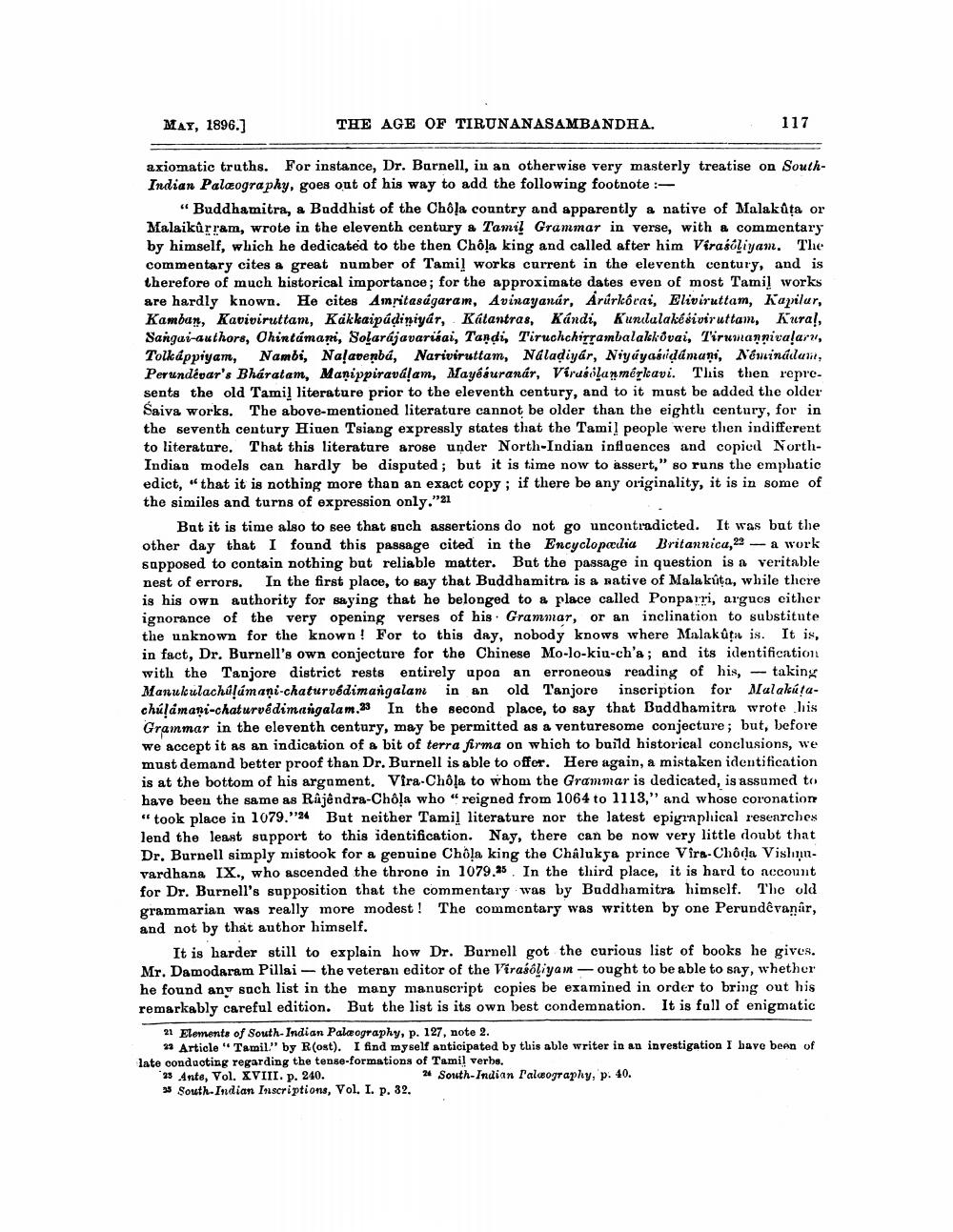________________
MAY, 1896.)
THE AGE OF TIRUNANASAMBANDHA.
117
axiomatic truths. For instance, Dr. Barnell, in an otherwise very masterly treatise on SouthIndian Palæography, goes out of his way to add the following footnote :
“Buddhamitra, a Buddhist of the Chôļa country and apparently a native of Malakuța or Malaikurram, wrote in the eleventh century & Tamil Grammar in verse, with a commentary by himself, which he dedicated to the then Chôla king and called after him Virasóliyam. The commentary cites a great number of Tamil works current in the eleventh century, and is therefore of much historical importance; for the approximate dates even of most Tamil works are hardly known. He cites Amritaságaram, Avinayanár, Arúrkôrai, Eliviruttam, kapilar, Kamban, Kaviviruttan, Kakkaipádiniyar, Katantras, Kándi, Kunilalakésiviruttam, Kural, Sangai-authors, Ohintámani, Solarajavarisai, Tandi, Tiruchchirrambalalckovai, Tirumannivaları, Tolkáppiyam, Nambi, Nalavenbá, Nariviruttam, Naladiyár, Niyáyasiidamani, Néminádum, Perundépar's Bharatam, Manippiraválam, Mayésuranár, Víruslanmérkavi. This then represents the old Tamil literature prior to the eleventh century, and to it must be added the older Saiva works. The above-mentioned literature cannot be older than the eighth century, for in the seventh century Hiuen Tsiang expressly states that the Tamil people were then indifferent to literature. That this literature arose under North-Indian influences and copied NorthIndian models can hardly be disputed; but it is time now to assert," so runs the emphatic edict," that it is nothing more than an exact copy; if there be any originality, it is in some of the similes and turns of expression only."21
But it is time also to see that such assertions do not go uncontradicted. It was but the other day that I found this passage cited in the Encyclopædia Britannica, 22- a work sapposed to contain nothing but reliable matter. But the passage in question is a veritable nest of errors. In the first place, to say that Buddhamitra is a native of Malaküta, while there is his own authority for saying that he belonged to a place called Ponparri, arguos cither ignorance of the very opening verses of his . Grammar, or an inclination to substitute the unknown for the known ! For to this day, nobody knows where Malakú is. It is, in fact, Dr. Burnell's own conjecture for the Chinese Mo-lo-kiu-ch'a; and its identification with the Tanjore district rests entirely upon an erroneous reading of his, - taking Manukulachülámani-chaturvedimangalam in an old Tanjore inscription for Malakútachúlámani-chaturvédimangalam.33 In the second place, to say that Buddhamitra wrote his Grammar in the eleventh century, may be permitted as a venturesome conjecture; but, before we accept it as an indication of a bit of terra firma on which to build historical conclusions, we must demand better proof than Dr. Burnell is able to offer. Here again, a mistaken identification is at the bottom of his argument. Vira-Chôļa to whom the Grammar is dedicated, is assumed to have been the same as Rajendra-Chola who " reigned from 1064 to 1113," and whose coronation " took place in 1079.24 But neither Tamil literature nor the latest epigraphical researches lend the least support to this identification. Nay, there can be now very little doubt that Dr. Burnell simply mistook for a genuine Chola king the Châlukya prince Vîra-Choda Vishnuvardhana IX., who ascended the throne in 1079.25. In the third place, it is hard to account for Dr. Burnell's supposition that the commentary was by Buddhamitra himself. The old grammarian was really more modest! The commcntary was written by one Perundêranar, and not by that author himself.
It is harder still to explain how Dr. Burnell got the curious list of books he gives. Mr. Damodaram Pillai - the veteran editor of the Virasóliyan - ought to be able to say, whether he found any such list in the many manuscript copies be examined in order to bring out his remarkably careful edition. But the list is its own best condemnation. It is full of enigmatic
21 Elements of South Indian Palæography, p. 127, note 2.
11 Article "Tamil." by R (ost). I find myself anticipated by this able writer in an investigation I have been of lato conducting regarding the tense-formations of Tamil verbs. 25 Ante, Vol. XVIII. p. 240.
24 South Indian l'alcography, p. 40. 35 South Indian Inscriptions, Vol. I. p. 32.




